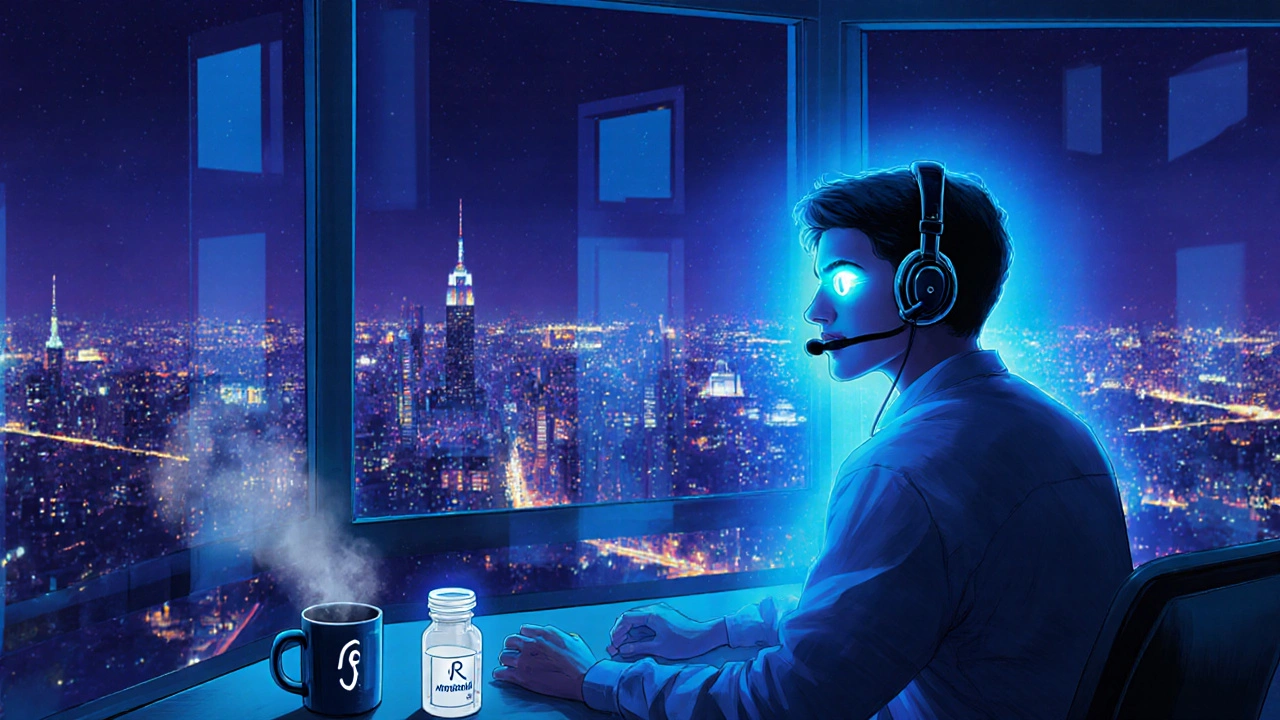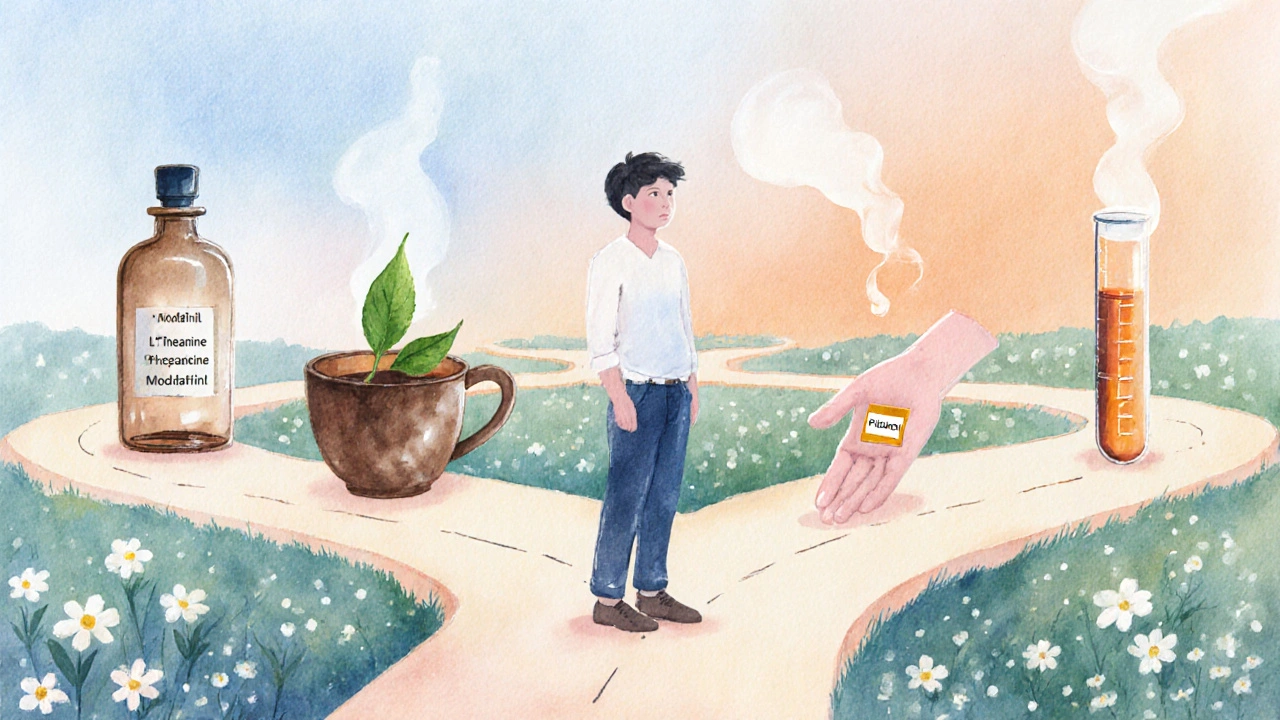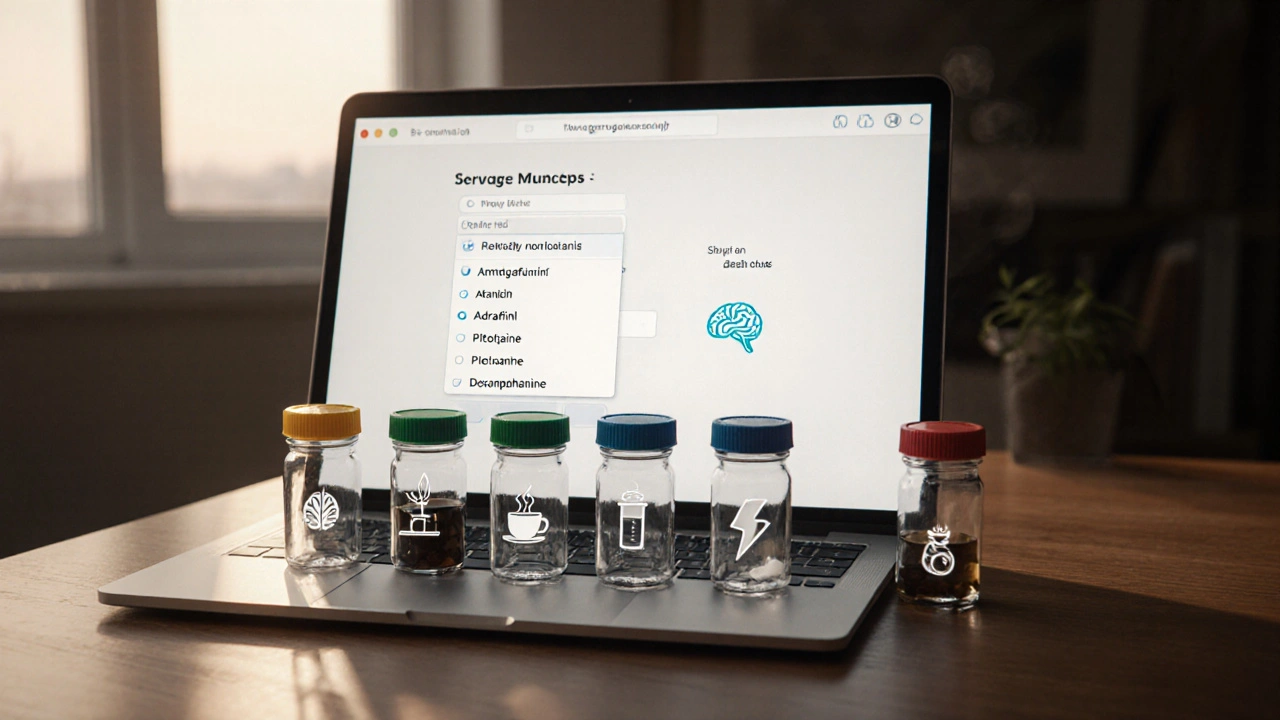Modafinil vs Alternatives: Drug Selector Tool
Recommended Options
Detailed Comparison
When you start hunting for a drug that keeps you awake, focused, and productive, the market feels like a maze. Modafinil comparison quickly becomes the first thing you type into a search engine. This guide cuts through the clutter by defining the most common alternatives, laying out their key traits, and showing you how to pick the right one for your lifestyle.
What Is Vilafinil (Modafinil)?
Modafinil is a prescription‑only wakefulness‑promoting agent originally approved for narcolepsy, shift‑work sleep disorder, and obstructive sleep apnea. Marketed under brand names like Provigil and generics such as Vilafinil, it works by boosting dopamine signaling and activating the orexin system, which together increase alertness without the jittery crash typical of stimulants.
Typical dosing runs 100‑200mg once daily, taken in the morning. Effects start within 30‑60minutes, peak at about two hours, and can last 10‑12hours. Because it isn’t a classic amphetamine, many users report fewer cardiovascular side‑effects, but it can still cause headaches, nausea, or reduced appetite.
Top Alternatives on the Market
Below are the most frequently discussed rivals. Each is introduced with a short definition and key attributes.
- Armodafinil - the R‑enantiomer of modafinil, marketed as Nuvigil. It offers a slightly longer half‑life (15hours) and may feel smoother for some users.
- Adrafinil - a pro‑drug that the body converts into modafinil. Legal in many countries without a prescription, but it strains the liver.
- Caffeine - the world’s most popular stimulant found in coffee, tea, and pills. Fast onset (5‑15min), short duration (3‑5hours), and a noticeable crash.
- L‑Theanine - an amino‑acid found in tea that smooths the edge of caffeine, improving focus without heightening heart rate.
- Pitolisant - a histamine‑H3 receptor antagonist approved in Europe for narcolepsy. It works via a different pathway, producing a “natural” wakefulness.
- Dexamphetamine - a classic amphetamine used for ADHD and narcolepsy. Stronger stimulant effect, higher abuse potential.
- Methylphenidate - another ADHD medication that provides sharp focus but can raise blood pressure.
- Nicotine - delivered via gum or patches, it raises alertness and attention, though health risks limit long‑term use.
Side‑by‑Side Comparison
| Drug | Mechanism | Onset | Duration | Legal status (US) | Typical price (30days) | Common side‑effects |
|---|---|---|---|---|---|---|
| Modafinil | Dopamine reuptake inhibition + orexin activation | 30‑60min | 10‑12h | Prescription | ≈$70‑$120 (generic) | Headache, nausea, insomnia |
| Armodafinil | Same as modafinil (R‑enantiomer) | 30‑60min | 12‑15h | Prescription | ≈$80‑$150 | Dry mouth, dizziness |
| Adrafinil | Pro‑drug → modafinil | 45‑90min | 10‑12h | Over‑the‑counter (in most countries) | ≈$30‑$50 | Liver strain, insomnia |
| Caffeine | Adenosine receptor antagonist | 5‑15min | 3‑5h | Legal (all) | Negligible | Jitters, upset stomach |
| L‑Theanine | Promotes alpha‑wave activity | 15‑30min | 6‑8h | Legal (all) | ≈$15‑$25 | Rare, mild headache |
| Pitolisant | Histamine‑H3 antagonism | 45‑60min | 10‑12h | Prescription (EU), limited US data | ≈$150‑$200 | Insomnia, anxiety |
| Dexamphetamine | Increases norepinephrine & dopamine release | 20‑30min | 8‑10h | Prescription | ≈$90‑$130 | Increased heart rate, appetite loss |
| Methylphenidate | Blocks dopamine & norepinephrine reuptake | 30‑45min | 6‑8h | Prescription | ≈$70‑$110 | Sleep disturbances, irritability |
| Nicotine | nAChR agonist, boosts acetylcholine signaling | 5‑10min | 2‑4h | OTC (gum/patch) | ≈$30‑$60 | Dependence, throat irritation |

Which One Is Best for You?
Think of the choice as matching a tool to a job. Below are typical scenarios and the drug that usually fits best.
- Long‑lasting daytime alertness for shift work: Armodafinil because of its extended half‑life.
- Budget‑conscious college student who wants a legal option: Adrafinil works, but combine with liver‑support supplements.
- Quick boost before an exam or meeting: Caffeine plus L‑Theanine for smoother focus.
- Need for a prescription‑free, low‑risk option: Pitolisant in countries where it’s approved.
- Maximum performance for a short window (e.g., gaming marathon): A low dose of Dexamphetamine under medical supervision.
Safety, Tolerability, and Legal Considerations
Even “soft” drugs have hidden costs. Here are the top red flags to watch.
- Prescription requirement: In the United States, Modafinil, Armodafinil, Dexamphetamine, and Methylphenidate are ScheduleIV or II substances. Buying them without a script can lead to legal trouble.
- Liver health: Adrafinil metabolizes into modafinil in the liver, raising ALT/AST levels if used daily for weeks.
- Cardiovascular strain: Amphetamines (Dexamphetamine, Methylphenidate) can elevate blood pressure; a baseline check is a must.
- Addiction potential: Nicotine and amphetamines carry high dependence risk. Even though Modafinil is less habit‑forming, tolerance can develop with chronic use.
- Pregnancy & breastfeeding: All listed compounds lack robust safety data; avoid unless a doctor explicitly approves.
How to Decide: A Quick Decision Tree
- Do you have a prescription?
- Yes → Choose between Modafinil, Armodafinil, or an amphetamine based on duration needed.
- No → Look at OTC options like Adrafinil, caffeine‑L‑theanine stacks, or legal histamine agents.
- Is liver health a concern? If yes, avoid Adrafinil and monitor liver enzymes when using Modafinil long‑term.
- Do you need a short‑acting boost (<4h)? Choose caffeine, nicotine, or low‑dose amphetamine under supervision.
- Is cost a primary factor? Compare generic modafinil ($70‑$120) vs adrafinil ($30‑$50) vs caffeine (near zero).
Follow this flow, and you’ll land on the most suitable option without trial‑and‑error guesswork.
Quick TL;DR Checklist
- Modafinil - 10‑12h, prescription, moderate side‑effects.
- Armodafinil - longer half‑life, same mechanism, pricier.
- Adrafinil - OTC, liver load, cheaper.
- Caffeine + L‑Theanine - cheap, fast, short‑term, low crash.
- Pitolisant - non‑dopamine pathway, prescription‑only in EU, good for night‑shifters.
- Dexamphetamine & Methylphenidate - strong, fast, higher abuse risk.
- Nicotine - legal OTC, short‑acting, addictive.

Frequently Asked Questions
Can I take Modafinil without a prescription?
In the United States, Modafinil is a ScheduleIV drug, so a doctor’s prescription is required. Some countries sell it OTC, but quality and dosage may vary.
Is Adrafinil safer for the liver than Modafinil?
No. Adrafinil converts to Modafinil in the liver, creating additional metabolic stress. Regular liver‑function tests are advised if you use it long‑term.
How does Pitolisant differ from Modafinil?
Pitolisant blocks histamine H3 receptors, leading to a more “natural” wakefulness without dopaminergic stimulation. It’s useful for people who experience anxiety on stimulants.
Can I stack caffeine with Modafinil?
Yes, many users add a cup of coffee for an extra boost, but it can increase jitteriness and heart rate. Start with a low caffeine dose and monitor how you feel.
What’s the cheapest legal alternative?
Caffeine combined with L‑Theanine provides a cost‑effective focus stack for under $20 a month and carries minimal side‑effects.
